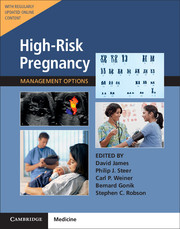Book contents
- Frontmatter
- Contents
- List of Contributors
- Preface
- Section 1 Prepregnancy Problems
- Section 2 Early Prenatal Problems
- Section 3 Late Prenatal – Fetal Problems
- 9 Prenatal Fetal Surveillance
- 10 Fetal Growth Disorders
- 11 Disorders of Amniotic Fluid
- 12 Fetal Hemolytic Disease
- 13 Fetal Thrombocytopenia
- 14 Fetal Cardiac Arrhythmias
- 15 Fetal Cardiac Abnormalities
- 16 Fetal Craniospinal and Facial Abnormalities
- 17 Fetal Genitourinary Abnormalities
- 18 Fetal Gastrointestinal and Abdominal Abnormalities
- 19 Fetal Skeletal Abnormalities
- 20 Fetal Tumors
- 21 Fetal Hydrops
- 22 Fetal Death
- Section 4 Problems Associated with Infection
- Section 5 Late Pregnancy – Maternal Problems
- Section 6 Late Prenatal – Obstetric Problems
- Section 7 Postnatal Problems
- Section 8 Normal Values
- Index
17 - Fetal Genitourinary Abnormalities
from Section 3 - Late Prenatal – Fetal Problems
- Frontmatter
- Contents
- List of Contributors
- Preface
- Section 1 Prepregnancy Problems
- Section 2 Early Prenatal Problems
- Section 3 Late Prenatal – Fetal Problems
- 9 Prenatal Fetal Surveillance
- 10 Fetal Growth Disorders
- 11 Disorders of Amniotic Fluid
- 12 Fetal Hemolytic Disease
- 13 Fetal Thrombocytopenia
- 14 Fetal Cardiac Arrhythmias
- 15 Fetal Cardiac Abnormalities
- 16 Fetal Craniospinal and Facial Abnormalities
- 17 Fetal Genitourinary Abnormalities
- 18 Fetal Gastrointestinal and Abdominal Abnormalities
- 19 Fetal Skeletal Abnormalities
- 20 Fetal Tumors
- 21 Fetal Hydrops
- 22 Fetal Death
- Section 4 Problems Associated with Infection
- Section 5 Late Pregnancy – Maternal Problems
- Section 6 Late Prenatal – Obstetric Problems
- Section 7 Postnatal Problems
- Section 8 Normal Values
- Index
Summary
Introduction
Congenital genitourinary tract anomalies are some of the most commonly identified prenatal abnormalities, being identified in between 1 in 250 and 1 in 1000 pregnancies. They consist of a wide spectrum of heterogeneous malformations. Obstructive uropathies account for the majority of these abnormalities.3–5 the second-trimester detailed scan (often at 18+0–21+6 weeks) is the examination in which the majority of genitourinary abnormalities are diagnosed. However, with the widespread use of first-trimester ultrasound screening, severe renal anomalies and “megacystis” are being noted between 11+0 and 13+6 weeks. Additionally, third-trimester ultrasound may reveal late-onset uropathies, often associated with changes in liquor volume.
Antenatal diagnosis allows for the planning of appropriate prenatal and postnatal care. In addition, it allows triage of the anomalies into those that are severe and potentially life-threatening, those that are amenable to in utero intervention, and those that may require postnatal investigation and follow-up. As with all prenatal diagnosis, an explanation of the condition to parents, with discussion of the range of outcomes, is mandatory.
Normal Sonographic Appearance of the Urinary Tract
A first-trimester ultrasound (see also Chapter 7) is offered to all pregnant women in the UK for:
• dating of the pregnancy
• exclusion of multiple pregnancy
• confirmation of viability, and
• to offer screening for autosomal aneuploidy (commonly at 11+0–13+6 weeks).
At this scan the fetal bladder may be identified in up to 93% of cases (Figure 17.1). If the crown–rump length is > 67 mm and the bladder cannot be visualized this should be considered as abnormal.
In the UK, a second-trimester scan is also offered to all women at about 20 weeks. The details of that scan are discussed in Chapter 7. During the second and third trimester, the bladder will empty and refill during the course of an ultrasound examination. The fetal bladder can be identified lying between the two umbilical arteries within the pelvis (identified by the use of color flow Doppler). The sonographic appearance of the kidneys is discussed below. The ureters and urethra are not normally visible.
- Type
- Chapter
- Information
- High-Risk Pregnancy: Management OptionsFive-Year Institutional Subscription with Online Updates, pp. 409 - 432Publisher: Cambridge University PressFirst published in: 2017



